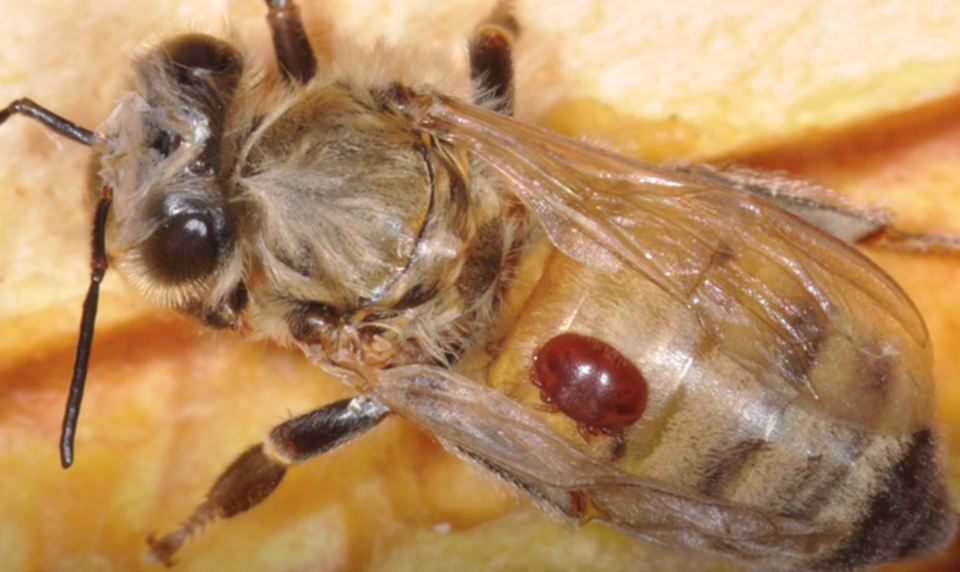Bees are in danger across Ontario this year as losses are wiping out many colonies.
One of the factors impacting the populations is a parasitic mite called varroa destructor, they infect honey bees.
They are an external parasite and feed on the bee pupae, and adult bees. They poke a hole in the bee and withdraw tissue and fluids, and then transmit a virus into the bee. The mites suppress the bees' immune response to the virus, explained Paul Kelly, research and apiary manager at the University of Guelph Honey Bee Research Centre.
“It’s pretty widespread. We’re hearing from lots of other provinces too and throughout Ontario. It’s significantly worse than other years,” said Kelly.
He said they won’t know the full extent of the losses until after they have conducted their survey at the end of June.
“It creates a very difficult situation for the beekeepers, especially people that are trying to earn their living at managing beehives,” said Kelly. “This is their income so when they lose a significant portion of their colonies it is a big challenge to recover economically.”
It could take beekeepers two to three years to recover, he said.
“Last year was a great year in one sense for the bees. Great weather, great colonies, the colonies grew quite big,” said Victoria MacPhail, pollination biologist for Pollination Guelph.. “As spring came early, fall was late; it left optimal conditions for these mites to increase numbers.”
Colonies of sick bees can be treated with a pesticide for mites.“Colonies that have a really good grooming behaviour, called hygienic behaviour, can decrease the number of mites in the colony. They’re able to kick it off their bodies and kick it out of the hive,” said MacPhail.
Colonies can be recovered to an extent if the queen bee keeps laying eggs, she said.
“Honey bees are domesticated animals, they’re livestock. So declines with them do not necessarily reflect declines in the wild pollinators," MacPhail said.
“I don’t think the 90 per cent losses is the normal for Ontario, it’s just the big talking point amongst some of the bigger beekeepers,” said Michael Barber, founder of Tri-City Bee Rescue.
“We haven’t lost that many hives. We’re somewhere around 40, 45 per cent overall,” he said.
Barber said it all comes down to bee management style. Honey production is secondary for Tri-City Bee Rescue and when they saw their mite level was higher than normal they gave up on their honey crop.
Barber said it was their fault beekeepers had higher losses because some of their hives had nectar and they allowed the bees to finish eating it. This meant their mite treatment was put on later and they now have twice the losses.
“Even though they could see the signs, they ignored them, in my opinion that’s what happened or they weren’t testing to see the signs at all,” he said about beekeepers who make their livelihood producing honey.
“We’re anticipating a lot less rescues. Not just because there are less bees but because the bees that are alive people are going to be paying more attention to their bees to recoup their losses,” said Barber.
At Tri-City Bee Rescue, when they rescue bees, they are put in a quarantine yard and aren’t moved until they are inspected, safe and are free from disease.
The hives are monitored for rural mites so their level doesn’t overwhelm the bees. Rural mites have a symbiotic relationship with imported Asian honey bees and live off them. For European honey bees they don’t have the skill to deal with rural mites.
Losses vary according to conditions and location for one area producer.
“I’m only finding 30 to 35 per cent dead,” said Jim Coneybeare, a third-generation beekeeper who runs Coneybeare Honey just north of Fergus.
In some of his hive locations dead bees are minimal. He said if varroa mites were the main killer of the bees, the loss would be 90 to 100 per cent, so other factors could be causing the loss.
At other hive locations he saw 100 per cent loss.
Another factor Coneybeare said might be contributing to bee loss is pesticides used for agriculture on farms. He said his hives that are not close to farms are doing better than ones near farms.
Fungicides, a type of pesticide used by some farms, are not always safe for pollinators. Only about 65 per cent are safe, he said.
Bees and beekeepers have been dealing with varroa mites for a number of years, said Coneybeare.
